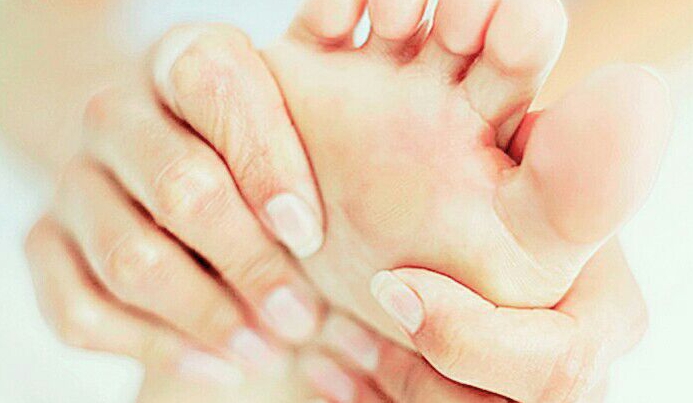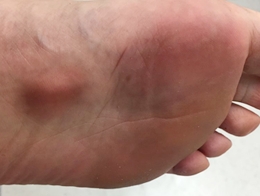Dry, Cracked Feet

Dry, cracked feet also known as heel fissures, refer to the presence of cuts along the upper layer of the skin of the sole. While any person can be affected, dry cracked feet are more common among athletes and people who suffer from conditions such as diabetes, thyroid disease, psoriasis and eczema.
Causes of Dry Cracked Feet
The most common causes of dry cracked feet are pressure (which is why athletes are one of those most affected) and dry skin. Conditions that either cause increased pressure or dry skin may result in dry cracked feet. These include:
- Deficiencies in diet: Several nutrients, if not taken in adequate quantities may result in dry cracked feet. A deficiency in iron, calcium, zinc, omega 3 and/or vitamin E has been demonstrated to result in dry feet.
- Using harsh soaps: Harsh soaps may alter the pH of skin, with effects mostly on the skin’s outermost layer. Use of harsh soaps results in dryness and tightness of skin, which is one of the predisposing factors for dry cracked feet.
- Cold weather: In cold weather, there is little humidity. This dryness, combined with the cold in the atmosphere, saps the essential oils from the skin. This results in drying which may lead to heel fissures.
- Walking and standing for long hours: This is related to increased pressure on the skin of the foot. Pressure is one of the reasons one may develop dry and cracked feet.
- Being overweight: Overweight individuals would have a large amount of weight exerted on the fat pad lying beneath the skin of their soles. This makes them susceptible to developing cracks in their feet.
- Continuous exposure to water: Continuous exposure to water has the same effect on skin as cold weather. The skin is deprived of its natural oils, resulting in it being dry, and thus, susceptible to developing cracks.
Naturally dry skin makes a person more susceptible to developing dry cracked skin on the soles of their feet. Such individuals would require less amounts or less exposure to any of the above causes of cracked skin, to develop it.
Signs and Symptoms
Dry cracked feet are predominantly a cosmetic problem rather than a medical problem, with most people seeking professional help due to the fact that their feet look unsightly. People with dry cracked skin may notice any of the following symptoms:
- Peeling of the skin on the soles
- Red flaky patches at the soles of the feet
- Itchiness along the sole
- Skin bleeding
In cases where someone has had dry cracked feet for a long period of time, and the severity of this condition has increased to include more layers of the skin, they may notice discharges or bleeding from the cracks. They may also have pain at the soles of their feet. Infection can also occur if proper hygiene is not maintained.
Home remedies
While there are many home remedy options, it is better to prevent the occurrence of dry cracked feet rather than try to treat them. Prevention is mostly through proper care of feet. This can be done through:
- Ensuring that your feet are clean: Whereas it may be hard to have clean feet at all times, we should endeavor to have clean feet as often as we can. This is achieved by thoroughly cleaning your feet, drying them properly after every wash and moisturizing them sufficiently.
- Regular exfoliation of feet: This would be helpful in removing dry flaky skin, and would go a long way in preventing dry cracked skin.
- Relaxing your feet: This is especially necessary following long periods of walking and standing. It can be done by placing and gently rubbing feet in alternating cold and warm water. The different temperatures help soothe the feet.
- Wearing socks overnight: This is particularly helpful for those who have naturally dry skin, but can also be used by those with normal skin. Wearing socks prevents the exposure of feet to harsh environments, for example it minimizes the effect of cold weather on one’s feet. Wearing socks also results in smoother, more pliable skin, preventing dry cracked feet.
- Wearing footwear/Shoes: Shoes help protect the skin of our soles from any damage from the ground. Walking barefoot exposes the skin to the rough ground and may directly result in cracks along the soles.
If one already has dry cracked feet, there are a variety of options to choose from to help relieve this problem. Most of these techniques require that they be done daily for a period of about one or two weeks or up to such a point where the cracks heal. These include:
Scrubbing the soles of the feet
Scrubbing helps exfoliate the skin, removing dry dead skin. Before scrubbing, it is recommended that one washes their feet in warm water. Soaking feet for a while in water may also be helpful in making the skin of the soles soft and easy to scrub without damaging it. Scrubbing can be done using a pumice stone, body scrub or a soft brush. A paste made from oatmeal may also be used as a homemade scrub. Honey and milk may also be combined as a paste to make a gentle nourishing exfoliant. After scrubbing, it is essential that the feet dry adequately. Wearing warm socks overnight may be of added benefit.
Use of petroleum jelly
In trying to heal dry cracked feet, petroleum jelly can be used on its own or in combination with lemon juice. Before applying, it is important to wash one’s feet and ensure that they are adequately dried. The benefit of petroleum jelly is that it maintains moisture. After applying a generous portion to both feet, it is recommended that one wears warm socks to prevent any moisture loss. Heated paraffin wax combined with either coconut oil or mustard oil may work in the same way as petroleum jelly.
Coconut or Olive oil
While coconut oil can be used in combination with paraffin wax, as stated above, it has been demonstrated to have certain benefits even if used on its own. Olive oil also works in a similar fashion to coconut oil. Both of these are important to minimize infections, which may result, particularly in cuts that run deeper than the epidermis. They also provide moisture, thus reducing dryness of the feet.
Bananas
Bananas are surprisingly beneficial for people with cracked feet. This healthy tasty fruit can be used to heal dry cracked feet. The preferred bananas are those that are slightly overripe, and thus, can be easily crushed or blended to form a paste. Each application requires one banana or two, depending on the size of the banana. After crushing or blending the bananas, the paste is them applied to the feet, and let to soak in for about fifteen minutes. Then, the feet are to be washed and gently dried. Wearing socks, may be of great benefit in ensuring smooth skin.
Aloe vera
The healing powers of aloe vera can be demonstrated once again in dry cracked feet. Aloe vera can be used on its own or in combination with a pinch of crushed basil leaves and a pinch of turmeric. This combination may be applied for not less than fifteen minutes then washed off.
Glycerin
Glycerin, used to moisturize skin, may be of benefit in dry cracked feet. Preferably, glycerin should be used together with lemon juice. If possible, one may add rose water to this combination. This combination should be used after washing and drying your feet, and before getting into bed. It should be left on overnight. It is recommended to use this even after the cracks heal to ensure that they is no recurrence of dry cracked feet.
White vinegar
Just like lemon juice, white vinegar is slightly acidic and is also used in healing dry cracked feet. One should soak feet in vinegar for about five to ten minutes. While soaking, it may be helpful to scrub the feet, after which, feet should be washed and dried adequately and then moisturized. This home remedy should preferably be done one to two times a week.
Use of a rub containing menthol
This includes Vicks rub. This requires application of the rub only around the cracked areas and only in a thin layer. After application, it is recommended that one wears a clean pair of socks. This rub is helpful, not only for healing any fungal infections, but also for providing essential oils to the skin of the sole.
Treatment
Despite there being many home remedies, there is also medical treatment available in case the home remedies do not work, or in some cases, worsen the cracks. These include:
- Use of sodium lactate, urea and glycerin preferably in a paste available as a medicated foot cream. Urea is a key component of the epidermis (the upper layer of the skin) that helps in water retention within the layers of the epidermis. Use of the above substances to make a paste that is then applied to the sole of the feet, prevents excessive loss of moisture, thus preventing the drying of feet, and enabling dry and cracked feet to heal adequately. This paste should be left on the feet overnight, then removed upon waking up.
- Antibacterial soaks: These may be administered even without evidence of infection to prevent the development of infection.
- Medication, in the form of creams or sprays, may also be given to treat any current fungal infection. For example, miconazole and clotrimazole foot creams.
- A dermatologist may also use ultra violet light treatment. However, this is reserved for severe cases that refuse to heal.





